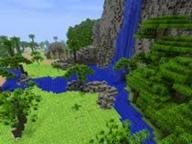Quiz Answer Key and Fun Facts
1. Redstone dust is very much the cornerstone of circuitry in 'Minecraft'. Typically, you will have a source of power with redstone dust leading away from it, transmitting the signal.
Without the aid of other mechanisms or items, will power travel through a redstone "wire" consistently for an unlimited number of blocks?
2. Redstone repeaters have a few uses, including adding delays to your circuit. A redstone repeater has four different delay settings that you can toggle, each one increasing the signal delay by how long?
3. Redstone torches, while they can be used as light sources (albeit weak ones), are, for a 'Minecraft' electrician, a source of power. However, you can toggle a redstone torch's state by doing what?
4. If you want to get into advanced wiring, you're probably going to have to learn about logic gates. If you needed to invert the signal in a section of a circuit, for instance, what sort of logic gate would you need to create? Assume this is a simple situation with one input and one output.
5. Many blocks and mechanisms can be affected by redstone. Which of the following is not one of those?
6. Pressure plates come in two flavours: standard and weighted. Which of these statements is true with regards to weighted pressure plates?
7. Unlike other minerals like iron and diamond, you cannot combine redstone dust to create a redstone block.
8. Suppose you fill a dispenser with arrows. A redstone circuit would be able to fire out arrows from the dispenser. What mechanism would you use instead if you want the items inside to simply be dropped out, in the same manner as if you'd just thrown them out of your inventory?
9. Redstone comparators are curious little mechanisms that do exactly what you'd expect: compare incoming signals and produce a certain output. But, which of these functions is not part of the comparator's repertoire?
10. Which of these scenarios is not possible by utilising redstone and redstone components?
Source: Author
eburge
This quiz was reviewed by FunTrivia editor
kyleisalive before going online.
Any errors found in FunTrivia content are routinely corrected through our feedback system.

